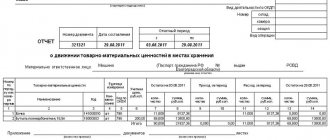Act – concept, structure, design
An act is a document drawn up by several persons (commission) in order to confirm established facts, events, actions.
Acts are drawn up both by permanent commissions and by those appointed by administrative document (order) at the direction of a higher organization or manager. In some cases, acts may be drawn up by one or more officials.[3]
In terms of their purpose and content, acts are very diverse, for example, an act of acceptance and transfer of material assets, an inspection act, a test act, an audit act, an act of violation of established rules, etc.
Here are examples of registration of acts .
The act reflects only those facts that are accurately established by the persons signing the document. Initially, rough records are kept to record progress and quantitative data. The final copy of the act is drawn up on general letterhead . For a significant number of repeating situations, unified stencil forms are created.
The required details of the act are : name of the organization, name of the type of document, date and registration number, place of preparation or publication, title to the text, signatures, and, if necessary, an approval stamp.[5]
The text of the act consists of three parts:
- Introduction . The administrative document on the basis of which the fact, event or action is activated, its number and date is indicated here. When listing the persons who participated in the preparation of the act, the names of positions with the designation of the organization, surnames and initials are indicated. If the act is drawn up by a commission, then the chairman of the commission is indicated first, followed by the names of the commission members in alphabetical order. If necessary, information is provided on documents proving the identity and powers of the persons participating in the preparation of the act, and their addresses.
- Statement part , which sets out the established facts.
- Conclusions (conclusions, recommendations, proposals are not contained in all acts, but are required in acts of inspections, surveys, audits, etc.).
All parts of the act are formatted in paragraphs, conclusions can be highlighted with an appropriate heading. A number of acts require approval; after approval of the act, the “Conclusions” acquire the force of an order and become mandatory for execution by the relevant officials.
At the end of the text of the act, the number of copies compiled and their location are indicated. The number of copies of the act is determined by the number of parties interested in it or by regulatory documents.
The signatures are arranged in the same sequence as the names in the introductory part, but without indicating the position. A person who does not agree with the contents of the act is obliged to sign it with a reservation about his disagreement. The special opinion of a commission member should be written on a separate sheet and attached to the report.[5]
The importance of legal acts of management in the Russian Federation
In legal proceedings, legal acts of government administration are very significant because:
- in some cases, they are the legal basis for the adoption of subsequent regulations by structures lower in the hierarchical ladder; for example, an order from the university management based on an order from the country’s Ministry of Education;
- all types of legal acts of management are an instrument for regulating legal relations, establishing the same rules of legal interaction for a wide or narrow circle of persons;
- act in the form of legal facts establishing the emergence or termination of legal relations; for example, issuing an order on the assumption of official duties by the Minister of Emergency Situations;
- can be the basis for initiating legal proceedings, and can also be considered as evidence during the conduct of the process.
Help - purpose, types, content, design
A certificate is a document drawn up to describe the facts of the main activity of an enterprise or confirm facts of a biographical or official nature.[3]
Here are examples of the preparation of certificates on production issues and personal matters.
Certificates on production issues can be drawn up at the request of management, at the request of another organization, or in connection with internal company rules for registration of specific aspects of the enterprise's activities. Such certificates can be internal and external.
External certificates - for submission to another (usually higher) organization - are drawn up on general form (or certificate form). Internal certificates - for presentation to the management of the organization or for consideration by a collegial body - are drawn up on a standard sheet of paper similar to a memo with the same details.
The text of the certificate, as a rule, consists of two parts: the first sets out the facts that served as the basis or reason for its preparation, the second provides specific information reflecting the essence of the issue.
The help text can only consist of one part. If the certificate contains homogeneous, systematized information, its text is presented in the form of a table. If the certificate includes information on several issues, its text may consist of several sections.
External certificates are signed by the head of the organization or his deputy. A certificate containing financial information is signed by the head of the organization and the chief accountant and certified with a seal. Internal certificates are signed by the head of a structural unit or a specialist compiler.[5]
Certificates drawn up to confirm biographical or official information are signed by two persons: the manager and the chief accountant or the manager and the head of the personnel department, and are certified by a seal. For such certificates, organizations use standardized forms with stencil text, and they can be drawn up on A5 format.[5]
The text of a personal certificate should begin with the last name, first name and patronymic of the employee (in the nominative case) to whom it was issued. In addition, the personal certificate indicates:
- an indication of what information the certificate was issued to certify;
- for what purposes or to what organization the certificate was issued;
- signature and indication of the position of the person who issued the certificate;
- date of compilation and stamp.
Certificates are drawn up in two copies, one is sent to the addressee, the other is filed in the file.
The required details of the certificate are : name of the organization (for internal - the name of the structural unit), name of the type of document, date and registration number, place of preparation (for external certificate), addressee, title to the text (for certificate issued in A4 format), signature, seal impression (for biographical and financial information). [5]
Situation in which the Work Accident Act is applicable:
If during the production activities of the enterprise an accident occurs that results in injury, minor or serious harm to the health of the Employee or another person participating in the production activities, or other consequences provided for by the Labor Code, the Employer has an obligation to take a number of actions. First of all, the Employer is obliged to:
- immediately organize first aid for the victim and transport him to a medical facility;
- take urgent measures to prevent the development of an emergency situation and the impact of traumatic factors on other persons;
- immediately inform the authorized authorities about the accident and, in case of serious accidents, the relatives of the victim;
- take other necessary measures to organize and ensure a proper and timely investigation of the accident and registration of investigation materials.
Documenting an industrial accident has features that must be taken into account. In particular, in accordance with the Labor Code of the Russian Federation, the Employer is obliged to conduct an investigation of the accident and draw up an appropriate Report on an industrial accident and send it within 24 hours to the authorities established by the Labor Code.
Structurality
Legislative acts should not be a jumbled collection of provisions. Typically, the document contains an introductory part. It is called the preamble. In a number of cases, it provides a description of the socio-political situation that existed at the time the act was approved. The purpose and purpose of the document must be stated (briefly). For example, it may be adopted to correct some international agreements of the Federation and certain legislative acts approved for their implementation.
Legal acts by legal content
Regulatory acts of management are the main legal basis for administrative bills. As a rule, they are designed for the long term for a large circle of people. Regulatory acts contain the basic rules of behavior (norms) governing legal relations in the state administrative apparatus. In addition, they determine the status of executive power structures, establish the procedure for performing government functions, and also delimit the sphere of influence and official powers of management bodies.
The difference between individual legal acts of public administration and normative ones lies primarily in the fact that they are unregulated in nature and do not contain norms (standard rules of behavior). These projects operate once, find their application to individual situations and are often addressed to a specific person or group of people. Thus, individual acts are nothing more than a volitional decision of a body (authorized person) of the executive branch associated with the emergence/termination of certain legal relations regarding a particular case. As an example, we can mention the Presidential decree on conferring the award and title of Hero of Russia to a citizen who has committed some valiant act or feat.
In practice, there are also mixed acts of government. A striking example is orders issued by ministries, which are designed for an indefinite amount of time and are intended for a large circle of people, but at the same time, specific actions of a specific official are required to implement the provisions of this act.
Classification of legal acts of management
When studying the types of management acts, it should be noted that the criterion of legal content is of greatest importance. In this regard, the main types of management documents are:
- regulations;
- individual.
In addition to the legal content, regulatory administrative acts can be grouped according to other criteria, namely:
- by issuing bodies (acts of the government of the Russian Federation, the president, etc.);
- by the nature of the competence of the issuing body (general, sectoral, intersectoral acts);
- on a territorial basis (federal acts, acts of constituent entities, acts of local governments).
Below we will consider all types in more detail.
Types of acts by issuing body
Administrative acts in Russia are issued by executive authorities of all levels: federal, at the level of constituent entities of the Russian Federation, as well as by local administration. Thus, the types of management acts by issuing bodies are as follows:
- Acts of the President of the Russian Federation, including decrees and orders.
- Government acts (orders, resolutions).
- Acts of the ministries of the Russian Federation include orders, resolutions, instructions, instructions and other regulatory documents that reflect and regulate legal relations in the industry subordinate to a particular ministry.
- Acts of the head of administration of a federal subject. The governor issues decrees and orders to perform the administrative functions of the executive branch at the level of the constituent entity of the Russian Federation.
- Acts of the head of the administrative body of a federal subject: orders and instructions.
- Acts of local administration (decrees, orders, orders).
The procedure for drawing up acts
Despite the fact that documents are used in different areas and may have their own specifics, they are subject to a number of general requirements. The rules for drawing up the act oblige the entity responsible for registration to include the following details in the form:
- Name of the parent organization (if there is one).
- Name of the enterprise where the document is drawn up.
- The name of the type of form (in this case, “Act”). Depending on the event or fact, a brief description is added to the name. For example, a certificate of completion of work, acceptance and transfer, and so on can be drawn up.
- Place of registration.
- Text.
- Indication of the presence of the application (if any).
- Signature and date of registration.
- Registration index.
View gallery
In some cases, the document must contain other details. For example, drawing up an inspection report involves including in the form information about the inspecting persons, their signatures, and marks of familiarization. Some documents must bear the stamp of approval or approval, the seal of the enterprise or the responsible person.
Final provisions
A seal acts as an additional requisite that gives a document legal effect. For some acts it is mandatory, for others it is recommended. However, in practice, the seal is usually present on almost all forms issued by the enterprise. Its presence allows you to avoid various problems, including those related to establishing the authenticity of a document. The seal certifies acts of acceptance of completed work, completed construction projects, and so on. In documents that must be approved by a higher official, the imprint is placed on the stamp. The legislation obliges those involved in the registration to familiarize themselves with the act. At the same time, they put their paintings next to the corresponding mark, their decoding and date.
View gallery
Design specifics
The drawing up of the act (in the absence of a unified form) is carried out on sheet A4. The title is a brief description of the recorded events or facts. The legislation does not impose strict requirements on it. When formatting, you need to ensure the consistency of words. It is allowed to formulate the title using a verbal noun (prepositional case) and the preposition “o”. For example, acts on/about can be drawn up:
- Loss and destruction of IDs and passes.
- Investigation of a production accident.
- Labor rationing.
- Equipping educational institutions.
View gallery
In other cases, the title can be formatted using a verbal noun placed in the genitive case. For example, acts of acceptance of work, issuance of documentation, verification of compliance with a collective agreement, readiness of design and estimate activities, and so on can be drawn up.
Requirements for legal acts and their contents
The content of a legal act of management consists in regulations dictating the norms of relationships in the field of public administration for persons holding administrative positions, as well as for the relevant structures. Also, the content of these acts may be the fact of establishment (termination) of administrative-legal relations. For example, an order for appointment to the post of Minister of Finance is a legal act of public administration, the content of which is to award an official the status of Minister of Finance of the country.
Since administrative legal acts are an instrument for the performance of state management functions, they must fulfill a number of mandatory requirements, namely:
- Legality, that is, compliance of the content of the act with the provisions of the basic laws of the country and the presence of legal grounds for its adoption. The procedure for adoption and publication of the document must also occur within the framework of the law with the mandatory indication of the necessary details.
- Correctness, which consists in a legally and spellingly correct presentation of the content, eliminating ambiguity in its interpretation. The structure of the document must also be observed: chapters, paragraphs and subparagraphs.
- Special requirements that apply to certain types of legal acts of management. This in some cases means time restrictions for the adoption of an act, the need for coordination and approval by certain officials and structures, and registration in registers.








